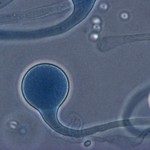Lien vers Pubmed [PMID] – 29147867
Lien DOI – 10.1007/s11046-017-0224-7
Mycopathologia 2018 Apr; 183(2): 381-390
Candida parapsilosis is a human commensal yeast, frequently involved in infection worldwide and especially in neonates. It is the second species responsible for bloodstream infections in Uruguay and the third species in France. We were interested in knowing whether the population structure of isolates responsible for candidemia in France and in Uruguay was different. Genotyping methods based on microsatellite length polymorphism (MLP) have been described and are especially used for investigation of local outbreaks. We therefore determined the genotypes of 159 C. parapsilosis isolates recovered from 122 patients (84 French patients from 43 hospitals and 38 Uruguayan patients from 10 hospitals) using three microsatellites markers previously described. Our results confirmed that C. parapsilosis population has a high genetic diversity, clonal inheritance and that majority of patients were infected by a single isolate. But we described recurrent infections due to related or unrelated genotypes resulting from isolates harboring loss or gain of heterozygosity. We also described three cases of coinfections due to unrelated genotypes. We did not uncover geographic specificity but observed two linked genotypes that seem to be associated with voriconazole resistance. Finally, among eight isolates involved in grouped cases, the genotypes were similar in six cases supporting the hypothesis of inter-patient transmission. These results confirmed the usefulness of performing MLP genotyping analysis for grouped cases of C. parapsilosis isolates in order to reinforce preventive hygiene measures.




